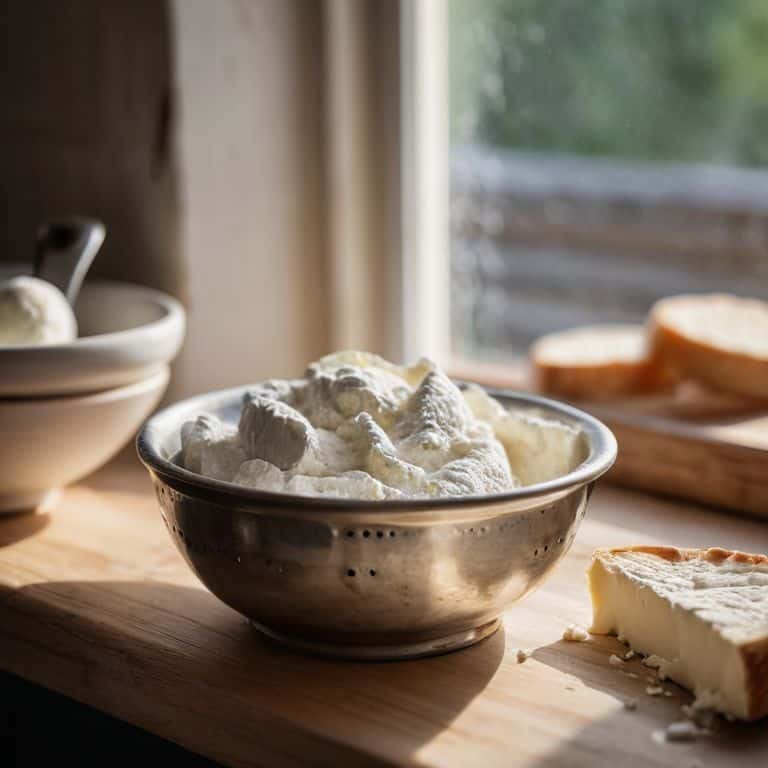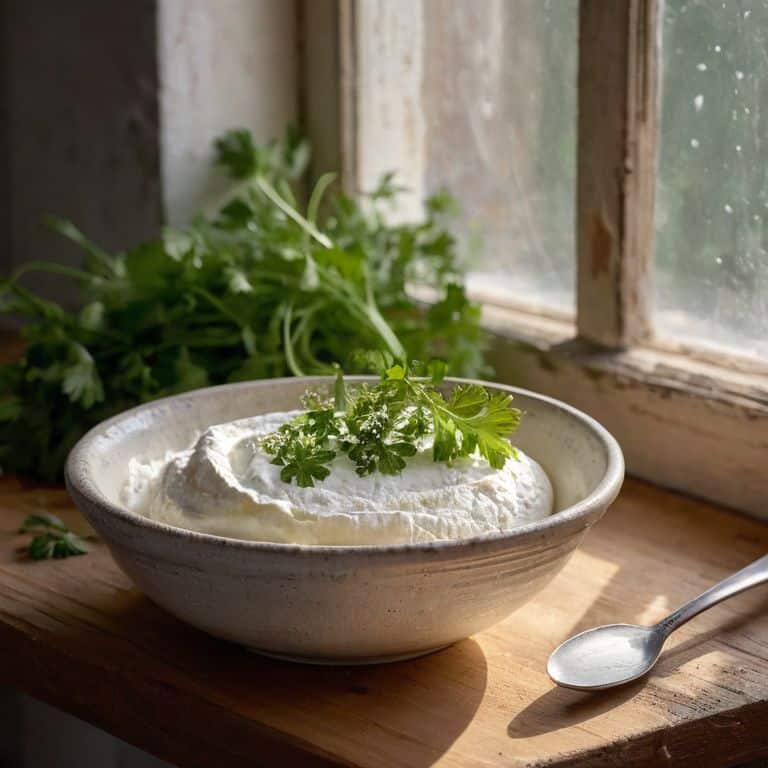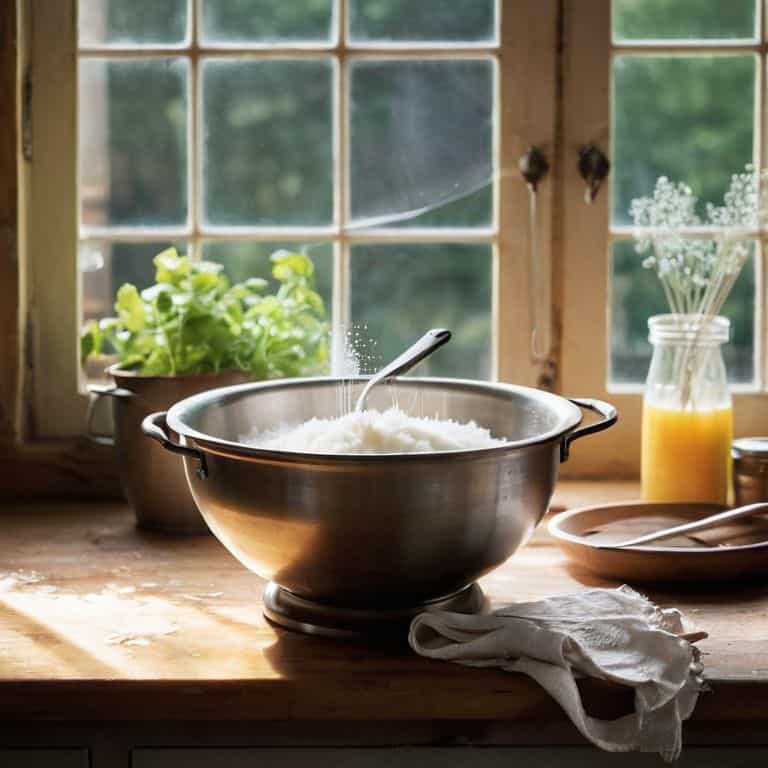I still remember the first time I tried to make fresh ricotta cheese at home – it was a game-changer. I had always thought it was some kind of mystical process, reserved for Italian nonnas and high-end chefs. But the truth is, learning how to make fresh ricotta cheese is ridiculously easy, and it’s about time someone spilled the beans. The myth that it’s complicated or requires special equipment is just that – a myth. With just a few simple ingredients and some basic kitchen tools, you can whip up a batch of creamy, dreamy ricotta in no time.
So, what can you expect from this article? I’ll walk you through the no-fuss process of making fresh ricotta cheese, from start to finish. You’ll learn how to combine just a few essential ingredients, like milk, cream, and vinegar, to create a deliciously tangy and creamy cheese. I’ll share my own tips and tricks for getting the best results, and by the end of it, you’ll be a ricotta-making pro. Whether you’re a seasoned foodie or just starting to get your hands dirty in the kitchen, this guide will show you that making fresh ricotta cheese is easier than you think, and it’s a great way to add some homemade flair to your favorite recipes.
Table of Contents
- Guide Overview: What You'll Need
- Step-by-Step Instructions
- Make Fresh Ricotta Cheese
- Get Creative with Your Curd: 5 Essential Tips for Making Fresh Ricotta Cheese
- 3 Key Takeaways to Get You Started
- The Ricotta Revelation
- Conclusion: You're Now a Fresh Ricotta Cheese Master
- Frequently Asked Questions
Guide Overview: What You'll Need

Total Time: 30 minutes to 1 hour
Estimated Cost: $10 – $20
Difficulty Level: Easy
Tools Required
- Medium Saucepan with a heavy bottom
- Candy Thermometer for monitoring temperature
- Cheesecloth or a clean, thin kitchen towel
- Colander for draining
Supplies & Materials
- 1 gallon Whole Milk
- 1/2 cup Heavy Cream optional
- 1/2 teaspoon Salt
- 1/4 teaspoon Vinegar or lemon juice
Step-by-Step Instructions
- 1. First, let’s start by gathering our ingredients and equipment, because having everything ready is key to a smooth and enjoyable ricotta-making process. We’ll need 1 cup of heavy cream, 1/2 cup of whole milk, 1/2 teaspoon of salt, and 1/4 teaspoon of vinegar or lemon juice. As for equipment, a medium saucepan, a candy thermometer, a colander, and some cheesecloth or a clean, thin kitchen towel will do the trick.
- 2. Next, combine the heavy cream, whole milk, and salt in the saucepan, and place it over medium heat, stirring occasionally. We’re aiming for a temperature of around 180°F to 190°F, so keep an eye on that thermometer. It’s essential to not let it boil, as this can lead to a grainy texture in our final product.
- 3. Once we’ve reached the desired temperature, remove the saucepan from the heat and stir in the vinegar or lemon juice. This is where the magic happens, and the mixture will start to curdle and separate. Let it sit for about 5 minutes, allowing it to cool slightly and the curds to firm up.
- 4. While we’re waiting, let’s prepare our draining station. Place the colander over a bowl or sink, and line it with cheesecloth or a clean, thin kitchen towel. This will help us catch all the whey and keep our ricotta nice and clean.
- 5. Now, it’s time to carefully pour the curd mixture into the prepared colander. Let it drain for about 10 to 15 minutes, or until most of the liquid has been removed and the ricotta has reached your desired consistency. You can speed up the process by gently pressing on the curds with your spatula or the back of a spoon.
- 6. Once we’ve achieved the perfect consistency, give the ricotta a good stir to break up any clumps, and transfer it to an airtight container. At this point, you can add some flavor to your ricotta, whether it’s a sprinkle of salt, some chopped herbs, or a drizzle of honey – the possibilities are endless.
- 7. Finally, cover that container and refrigerate it for at least 30 minutes to allow the flavors to meld together and the ricotta to chill. And that’s it – you’ve just made your very own fresh ricotta cheese, ready to be used in all sorts of delicious recipes. Give yourself a pat on the back, and get ready to enjoy the creamy, dreamy goodness you’ve created.
Make Fresh Ricotta Cheese

As I always say, the key to amazing homemade ricotta is in the details. When it comes to choosing the right milk, I’m a big fan of using pasteurized milk for cheesemaking. It’s easy to find and works beautifully for our purposes. Plus, it’s a great way to ensure that your ricotta turns out smooth and creamy.
Now, let’s talk about cheesecloth substitutes. I’ve found that a clean, thin kitchen towel or even a piece of butter muslin can work beautifully in a pinch. Just be sure to give it a good rinse and squeeze out any excess water before using. And don’t worry if you don’t have any specialized simple cheesemaking equipment – a big pot and a strainer are all you really need to get started.
One of my favorite things about making ricotta is how versatile it is. You can add a squeeze of lemon juice to give it a bright, tangy flavor or try out different seasons and spices to create unique flavor profiles. And the best part? Easy ricotta cheese recipes like this one are perfect for using up in all sorts of dishes, from lasagna to pancakes. Whether you’re a seasoned pro or just starting out, I encourage you to experiment and find your own favorite ways to use this delicious homemade cheese.
Easy Recipes With Lemon Juice
Now that we’ve got our fresh ricotta cheese, let’s talk about one of my favorite ways to elevate it – with a squeeze of lemon juice. I love using lemon juice in my recipes because it adds a brightness and depth of flavor that’s just incredible. One of my go-to recipes is a simple lemon ricotta spread: just mix your freshly made ricotta with some lemon juice, zest, and a bit of honey, and you’ve got a delicious dip for crackers or veggies.
I also like to use lemon juice to make a mean lemon ricotta pancake. Just substitute some of the liquid in your pancake recipe with lemon juice, and add in some ricotta cheese for an extra-fluffy stack. The acidity of the lemon juice pairs perfectly with the richness of the ricotta, making for a truly unforgettable breakfast treat. Give it a try and see what you think!
Homemade vs Store Bought Benefits
The difference between homemade and store-bought ricotta is like night and day. When you make it yourself, you can control the ingredients and the process, which means you can tailor the flavor and texture to your liking. Plus, homemade ricotta is incredibly fresh, which makes a huge difference in the end result. I mean, have you ever tasted ricotta that’s been sitting on a supermarket shelf for who-knows-how-long? It’s just not the same as the creamy, dreamy stuff you can whip up in your own kitchen.
By making your own ricotta, you’re also avoiding all the preservatives and additives that can come with store-bought versions. And let’s be real, there’s something pretty satisfying about creating something delicious from scratch. It’s like a little victory for your taste buds and your sense of self-sufficiency.
Get Creative with Your Curd: 5 Essential Tips for Making Fresh Ricotta Cheese

- Experiment with Acid: Don’t be afraid to try different acids like lemon juice or vinegar to coagulate your milk – it’s all about finding the flavor you love
- Temperature Tango: Keep an eye on your thermometer, as the ideal temperature for coagulation is between 180°F and 190°F – don’t let it get too hot, or you’ll end up with tough curds
- Drain with Care: Line your colander with cheesecloth or a clean, thin kitchen towel, and gently squeeze out excess liquid to achieve the perfect consistency
- Season to Perfection: Add a pinch of salt, some chopped fresh herbs, or a drizzle of honey to give your ricotta a unique twist – remember, the possibilities are endless
- Practice Makes Perfect: Don’t be discouraged if your first batch doesn’t turn out exactly as you hoped – keep trying, and you’ll soon develop a feel for the process, and your ricotta will be creamy, dreamy, and utterly delicious
3 Key Takeaways to Get You Started
Making fresh ricotta cheese at home is a game-changer – it’s ridiculously easy, and the flavor and texture are worlds apart from store-bought versions
With just a few simple ingredients and some basic equipment, you can whip up a batch of creamy, dreamy ricotta in no time, and use it as a base for all sorts of delicious recipes
By taking the leap and making your own ricotta, you’ll not only be treating your taste buds to something amazing, but you’ll also be joining a community of DIY food enthusiasts who are passionate about creating something real and meaningful in their own kitchens
The Ricotta Revelation
The beauty of making fresh ricotta cheese lies not in the precision of the recipe, but in the gentle chaos of the process – it’s a reminder that sometimes, the most magical flavors emerge from a little bit of mess and a whole lot of heart.
Tom Navarro
Conclusion: You're Now a Fresh Ricotta Cheese Master
As we wrap up this journey to making fresh ricotta cheese, let’s recap the key takeaways: we’ve learned that with just a few ingredients and some basic equipment, you can create your own delicious, creamy ricotta at home. From the ease of using lemon juice to the numerous benefits of opting for homemade over store-bought, the process is not only straightforward but also highly rewarding. By embracing the DIY spirit and getting your hands a little messy, you’ve unlocked the door to a world of culinary possibilities, where the freshness and quality of your ingredients shine through in every dish.
So, as you stand in your kitchen, surrounded by the simple yet powerful tools of your trade, remember that the true magic lies not in the recipes or the techniques, but in the act of creation itself. Every time you decide to make something from scratch, you’re not just cooking; you’re reviving traditions, supporting local communities, and crafting memories that will linger long after the last bite is savored. Keep experimenting, keep pushing the boundaries of what’s possible, and most importantly, keep enjoying the journey – your taste buds, and the people you share your creations with, will thank you.
Frequently Asked Questions
What's the best type of milk to use for making fresh ricotta cheese?
Hands down, I’m a fan of using whole milk for my ricotta – the creaminess is unbeatable! But, I’ve also had great luck with a combo of whole and heavy cream for an extra-rich cheese. Avoid skim milk, it’s just too thin. Trust me, the extra fat is worth it for that luscious texture.
Can I flavor my homemade ricotta cheese with ingredients like garlic or herbs?
Absolutely, get creative with it! I love mixing in some roasted garlic or chopped fresh herbs like parsley or dill into my homemade ricotta. It’s a game-changer for adding depth to sauces, soups, or spreads. Just be sure to taste as you go and adjust to your liking – the beauty of homemade is making it your own!
How long does fresh ricotta cheese last in the fridge and can it be frozen for later use?
Fresh ricotta typically lasts 3-5 days in the fridge. As for freezing, it’s a bit tricky – the texture can get watery when thawed. But, if you’re looking to preserve it for later, I say go for it! Just be sure to whip it up again after thawing to get that creamy magic back.
